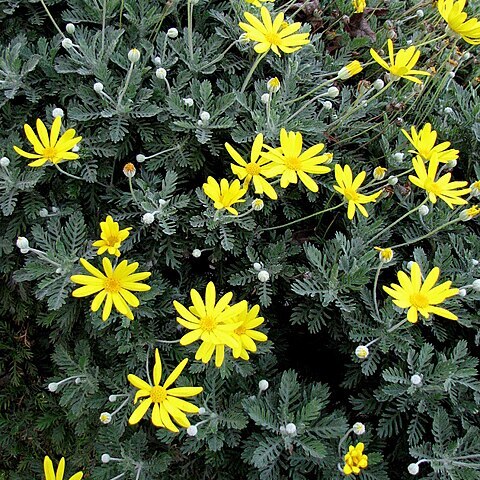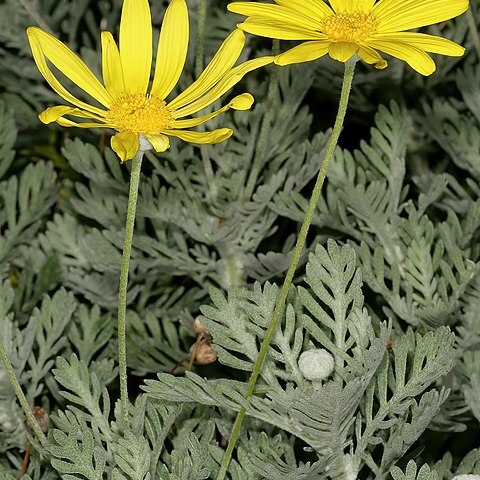Shrub vigorous, richly branching, 0.5-2 m high, often rather dense and wide, densely tomentose throughout, seldom glabrate or glabrous. Branches suberect-ascending, closely leafy towards the tips, lower down defoliated. Leaves erecto-patent-spreading, 4-10 cm long, 1-3 cm wide, flat, herbaceous or subcoriaceous, light or silvery grey with a dense appressed tomentum, closely pinnatipartite or pinnatilobate in the distal half; the proximal half entire and petiole-like, linear, 2-3 mm wide, with a + distinct midrib. Leaf-lobes 4-10 on each side, opposite or sub-opposite-alternate, parallel, linear, 3-20 mm long, 2-3 mm wide, obtuse, entire or with a bifid to few-toothed apex, seldom pinnatifid with a few pairs of short lobes. Peduncles terminal, solitary or a few together, erect, (3-)6-13(-16) cm long, 1-2 mm thick, terete or somewhat striate. Involucre cupshaped, (6-)9-11 mm wide, (7-)9-12 mm high, many-veined under the tomentum. Involucral bracts 11-17, uniseriate, connate to 3/4-4/5; the free lobes narrowly triangular, 2-4 mm long, acute or slightly acuminate, puberulous-tipped. Receptacle flat or slightly convex, shallowly alveolate. Ray-florets (10-)13-18, yellow. Tube 2.5-3 mm long, cylindrical. Lamina oblanceolate-narrowly oblong-obovate, 10-22 mm long, 4-7 mm wide, 7-veined. Style terete or somewhat flattened, with swollen base; style branches 1-1.5 mm long, truncate, with a few rudimentary sweeping-hairs. Disc-florets c. 40-100. Corolla 5.5-6.6 mm long, tubular and gradually widening above; lobes deltoid-narrowly triangular, 0.7-1 mm long. Anthers 2-2.5 mm long inch the ovate appendage. Style somewhat flattened, with swollen base; style branches 1-1.5 mm long, truncate. Pappus bristles copious, up to 4 mm long, white, erect, the outer bristles shorter and reflexed over the ovary. Achenes fusiform-narrowly elliptic-oblong, 4-6 mm long, 1-2.5 mm wide, often somewhat compressed or triquetrous, sometimes curved, glabrous, dark brown, shiny, with 8-10 thick, often blackish ribs.
More
Densely grey-felted shrub to over 1.5 m. Leaves toothed to pinnatisect, 40-100 mm long, lobes linear, obtuse to acute. Flower heads radiate, large, solitary on stout, elongate peduncles in upper leaf axils, with cup-shaped involucre, yellow, disc florets obconic.


